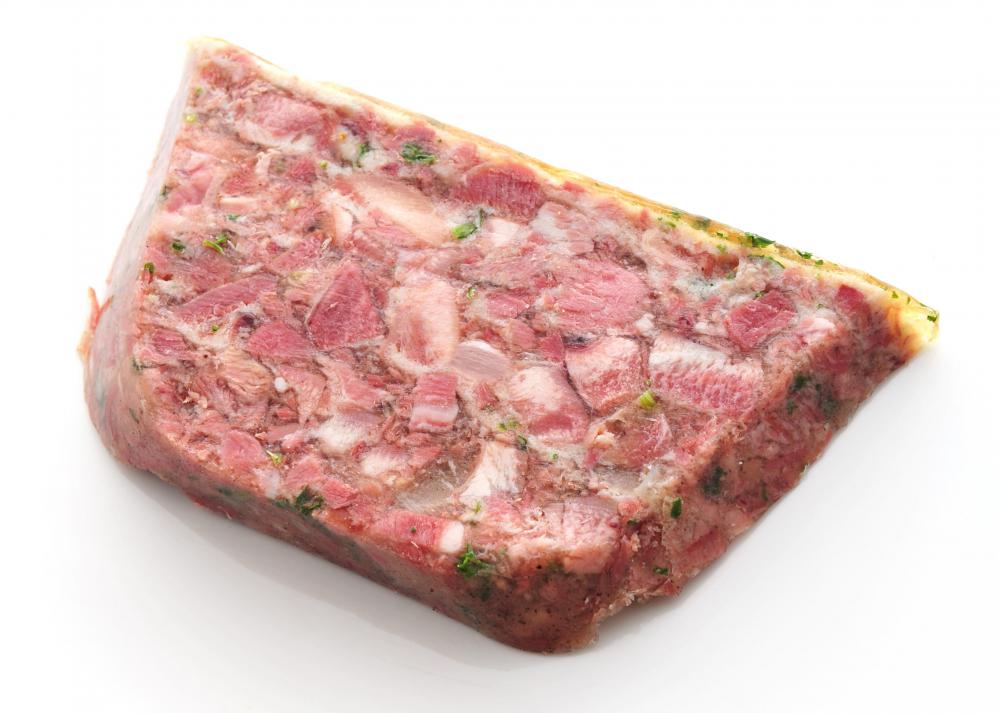At WiseGEEK, we're committed to delivering accurate, trustworthy information. Our expert-authored content is rigorously fact-checked and sourced from credible authorities. Discover how we uphold the highest standards in providing you with reliable knowledge.
What Are the Best Tips for Making Head Cheese?
Making head cheese can sometimes be a complicated and unpleasant process, but there are a few things that both first-timers and experts can do to make the process simpler. Those purchasing meat should buy it already cleaned to avoid the messy process of removing the organs from the skull. Making head cheese usually takes a long time, so having patience is also key.
Some may not find cleaning a pig’s head for head cheese disagreeable, but the process can take a long time, whether one is experienced with butchery or not. Those that do not own pigs, but still want to make head cheese, may benefit from spending a little extra money on a previously cleaned head. These pieces are already divested of skin, eyes, tongue, and brains. The only meat typically left on a cleaned pig’s head is the muscle tissue.

Those that want to include hocks, tongue, and other organ meats in their head cheese may want to purchase them already cleaned and ground. The meat on the pig’s head, when boiled, will typically form a very soft, gelled meat similar to bulk sausage. Purchasing additional, already ground meats generally saves the cook some work in the long run.
Cooks both new and experienced at making head cheese should not skip any steps in the process. Choosing not to brine the meat could result in a bland, flavorless head cheese. Brine generally contains water, salt, and sometimes a few pickling spices. Soaking the head in this mixture for at least 12 hours infuses it with salt and brings out the natural flavors of the meat.

Boiling the head for the right amount of time is usually very important. Proper timing usually ensures that about 95% of the meat will separate from the skull, eliminating the need to scrape or pull meat from the bone. Most heads require up to four hours of boiling time, though a very large head may require an additional hour or so. The cook may create his or her own stock for boiling the head, or purchase pre-made vegetable or chicken stock.
The head must fit into the boiling pot with at least 3 or 4 inches (about 6 to 8 cm) to spare. This typically allows the liquid in the pot to simmer steadily without causing the mixture to boil over. If it does boil over, the cook must add more liquid to the pot because the head should be covered by liquid during the entire boiling process.
The stock should thicken as the head boils, and achieve a consistency much like liquid soap or thin honey. If it doesn’t thicken after about two and a half hours of cooking, adding a handful of gelatin powder may speed the process. Once the head is done boiling, the cook can generally remove the skull, which should be bare of meat, and funnel the mixture into 4 to 6 inch (about 8 to 12 cm) diameter sausage casings. The head cheese must then cool for at least 12 hours after packaging.
AS FEATURED ON:
AS FEATURED ON:












Discussion Comments
I've heard of head cheese all my life, and I've even seen it in some really local grocery stores. I guess I'm just not a very enlightened eater, but not only would I never make the stuff, I'd never touch it!
I can't imagine what a strong stomach you'd have to have to deal with the whole process of making head cheese. It's right up there along with cleaning and boiling chitlins. Nasty -- and very, very smelly. I can appreciate the process, but it's not for me.
Post your comments